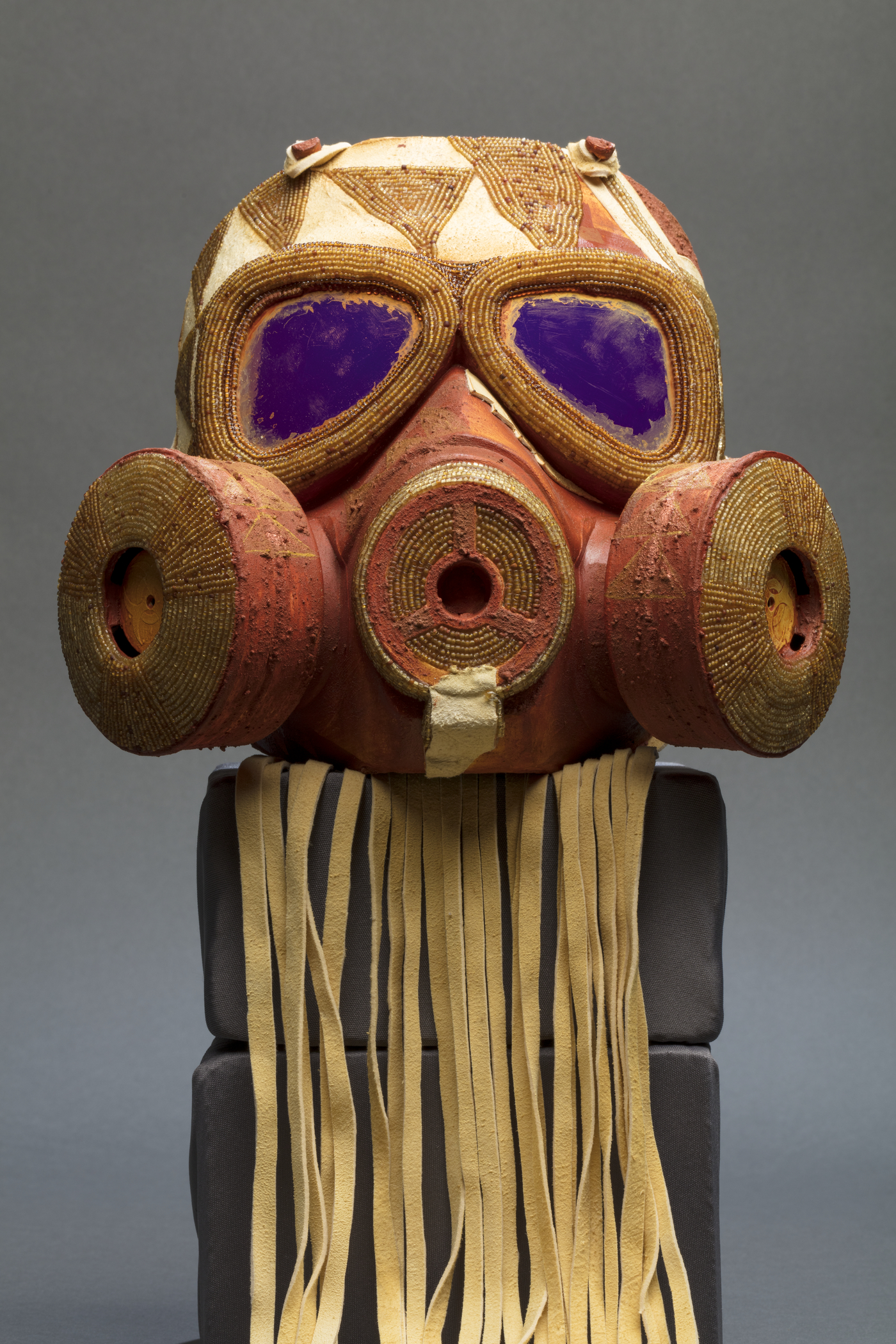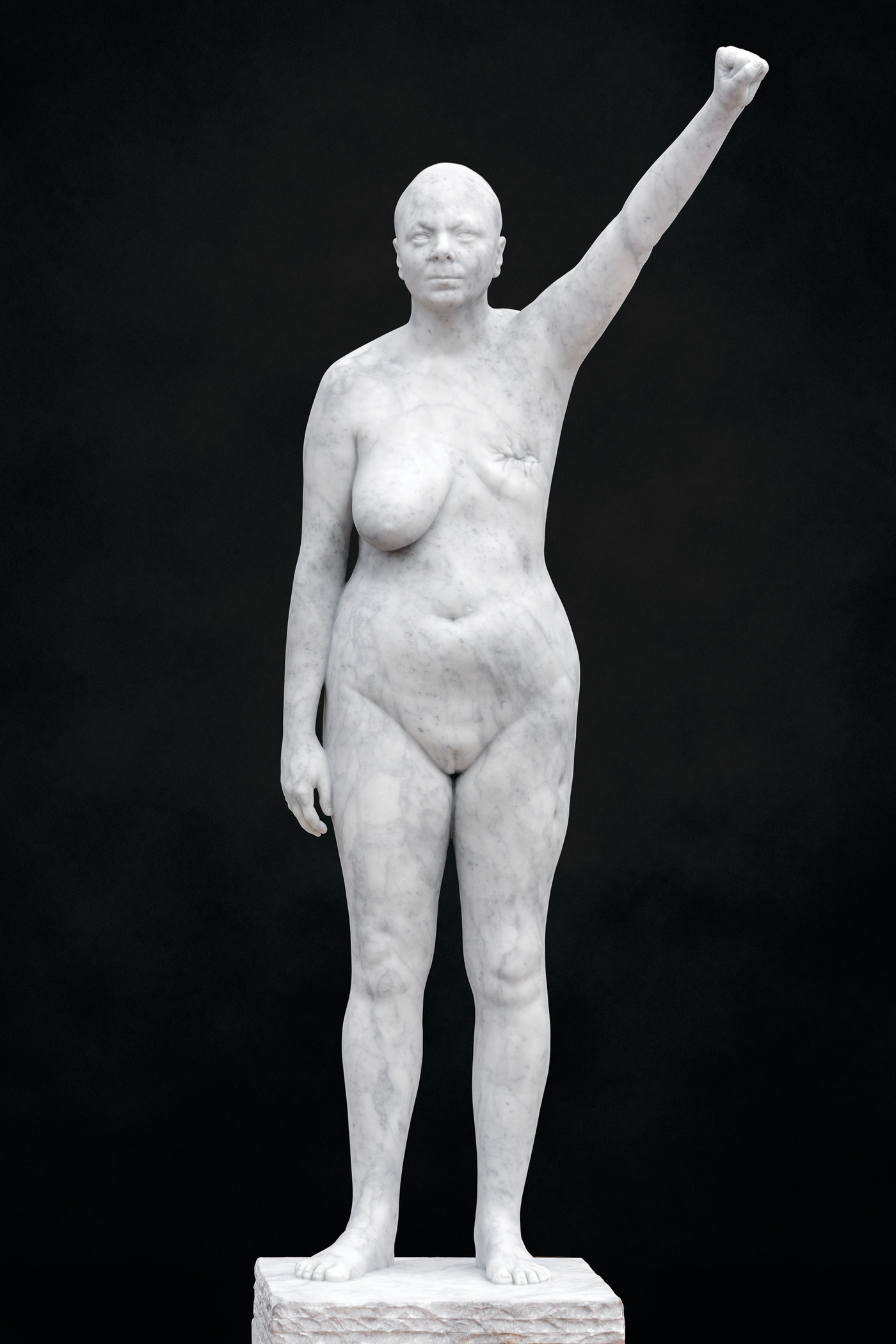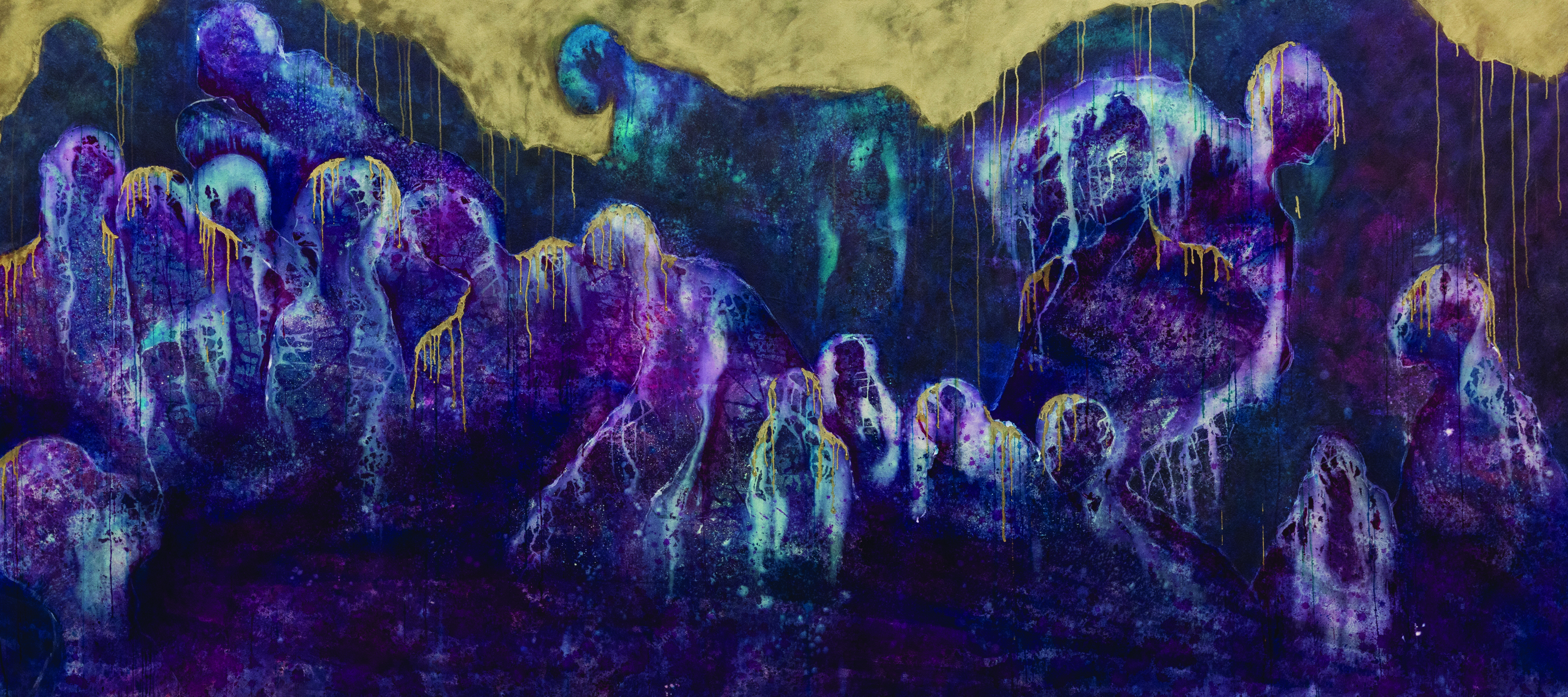WASHINGTON—The National Museum of Women in the Arts (NMWA) presents New Worlds: Women to Watch 2024, the largest edition of the museum’s longstanding series featuring international emerging artists. Opening April 14, the exhibition highlights the work of 28 visionary artists who imagine alternate realities. With perspectives that shift across geographies, cultural viewpoints and mediums, the artists inspire viewers to envision different futures. New Worlds: Women to Watch 2024 is on view through August 11, 2024.
During the past few years, artists have seen the world transformed by a global pandemic, political division, climate change and advocacy for social reform. Their responses to these extraordinary times—in paintings, sculpture, photography, installation, video and textiles—highlight their visions for creating or re-creating a new world, whether exploring facets of the past, present or future. The exhibition will be accompanied by performances and artist talks, to be announced in the coming months.
“The artists in New Worlds, many who have created work specifically for this exhibition, are being recognized for challenging today’s status quo, encouraging us to see issues from multiple viewpoints and envisioning different futures than most of the rest of us can possibly imagine,” said NMWA Director Susan Fisher Sterling.
Presented every three years, the Women to Watch series is a dynamic collaboration between the museum and its global network of outreach committees. The national and international committees participating in New Worlds worked with curators in their regions to create shortlists of artists. From this list, NMWA curators selected the artists and works to exhibit at the museum. The second major exhibition after NMWA’s reopening from a transformative multi-year renovation, New Worlds will immerse visitors in the museum’s renewed gallery spaces. The exhibition features seven works created specifically for NMWA, including several site-specific installations.

Representing the museum’s outreach committees, New Worlds features works by Irina Kirchuk (Argentina), Saskia Jordá (Arizona), Aimée Papazian (Arkansas), Nicki Green (Northern California), April Banks (Southern California), Meryl McMaster (Canada), Francisca Rojas Pohlhammer (Chile), Ana María Hernando (Colorado), Randa Maroufi (France), Marianna Dixon Williams (Georgia), Sophia Pompéry (Germany), Rajyashri Goody (India), Hannan Abu-Hussein (Israel), Irene Fenara (Italy), Ai Hasegawa (Japan), Mona Cliff/HanukGahNé (Spotted Cloud) (Greater Kansas City Area), Daniela Rivera (Massachusetts), SHAN Wallace (Mid-Atlantic Region), Alexis McGrigg (Mississippi), Eliza Naranjo Morse (New Mexico), Amanda Phingbodhipakkiya (New York), Migiwa Orimo (Ohio), Graciela Arias Salazar (Peru), Marina Vargas (Spain), Arely Morales (Texas), Noémie Goudal (U.K.), Molly Vaughan (Washington) and Sarah Ortegon HighWalking (Wyoming).
Some artists consider how public and private spaces are gendered, offering alternatives to the status quo. Others explore the idea of place itself, addressing the movement of people across geographies, generations and even planes of existence. Several artists use digital strategies to probe topics such as environmental values, bioethics and artificial intelligence. Artists also look to the power of communities to shape identity or question the nature of time, tradition and collective memory.
A press preview will be held on Tuesday, April 9 at 10 a.m. and feature a tour with curator Virginia Treanor.
Disrupting Gendered Spaces
Public spaces as well as domestic spheres are ripe for reevaluation, reimagination and reconsideration. Asserting her visibility, a nude self-portrait by Marina Vargas (Spain; b. 1980) frankly depicts the aftermath of mastectomy and cancer treatment on the female body. Vargas uses the visual language of classical sculpture to question the idealization of the female form in art and to critique the hyper-masculine imagery of many public monuments.

The work of Francisca Rojas Pohlhammer (Chile; b. 1985) challenges gender norms by inserting women into a traditionally masculine sphere: the military. Adapting traditional female figurines made of clay by generations of women in Quinchamalí, Chile, Rojas Pohlhammer replaces the guitar that the figures usually hold with a rifle.
Placemaking
Other artists explore the ways that people construct ideas about place, from physical movement across geographic borders to the metaphysical spaces of spiritual beings. The impact of place on identity and belonging is at the heart of Raíces (Roots) (2019), by Saskia Jordá (Arizona; b. 1978), in which tendril-like cords evoke roots pulled from the ground. Anthropomorphized by the cast feet at their bases, these totemic structures stand in for the artist and her grandmothers, referencing intergenerational migration and cultural separation.
Visualizing the spiritual realm is central to the work of Alexis McGrigg (Mississippi; b. 1989), who portrays spectral beings occupying other planes of existence. McGrigg’s work asserts her belief that placemaking is not confined to the physical world and identity is not limited to corporeal traits. Graciela Arias Salazar (Peru; b. 1978) portrays the celestial origin story of the Shipibo-Conibo, an Indigenous group in the Peruvian Amazon, in brightly colored scenes painted on ten machetes, a tool necessary for survival in the jungle.
Ecologies
Interconnections between people and their environments is a particularly salient theme. The short film Below the Deep South (2021) by Noémie Goudal (U.K., b. 1984) converts paleoclimatology theories into a visceral experience of combusting forests. Her work explores both the crisis facing global ecosystems and the unending cycle of Earth’s change. Sophia Pompéry (Germany; b. 1984) also questions the limitations and inadequacies of people’s methods to measure and tabulate Earth’s constant state of flux. Her work Fluten (Floods) (2023) consists of a map of light pollution in the Arctic Circle.
Technologies
Technology offers new ways to critique existing realities and imagine new possibilities. Irene Fenara (Italy; b. 1990) explores how technology can change our perception of reality. With a generative algorithm and 3,000 images of tigers (the approximate number of endangered wild tigers on the planet), she created digital imagery that reflects the algorithm’s incomplete interpretation of a tiger. Such programs need millions of images to accurately amalgamate a picture; Fenara’s work implies that the tiger looms larger in our media and imaginations than it does in nature. In (Im)possible Baby (2015), a mixed-media installation comprising photography, videos and texts, Ai Hasegawa (Japan; b. 1979) uses a simulation to analyze the DNA data of a same-sex female couple and visualize their potential genetically related children. Hasegawa hopes to inspire debate about the ethics of such reproduction and the possibilities it offers in building a more inclusive global society. An interactive installation by Amanda Phingbodhipakkiya (New York; b. 1988) explores the ethics of biological and technological advances, inviting visitors to engage directly with a post-apocalyptic embodied artificial intelligence to consider near-future scenarios.
Collective Forces
A number of artists explore the ways in which some communities have used group identity to grapple with past oppressions or to celebrate solidarity. Rajyashri Goody (India, b. 1990) a member of the Dalit people of the Hindu caste system in India, sources her content from literature, poetry and cookbooks that speak to trauma, hunger, unity and resistance in her community. Through sculptural installations made of ceramic foods, Goody reveals how deprivation led Dalits to forage resources and invent new recipes.
Art and activism also intersect in the work of Molly Vaughan (Washington; b. 1977), who aims to increase visibility of the gender nonconforming community. In her ongoing series “Project 42” (launched in 2012), Vaughan creates garments honoring the lives of transgender women who have been victims of violence and invisibility.
SHAN Wallace (Mid-Atlantic; b. 1991) creates collages that pay homage to her Baltimore community and the spectrum of Black experience in the United States. In Pale Blue Egun (2024), Wallace fuses folklore and fantasy in the central figure of the Egun, an embodiment of ancestors in Yoruba tradition, guiding others through a universe separated from our present understanding of reality.
Future Ancient
New Worlds features artists who think beyond linear perceptions of time. In Past/Presence/Future (2020) by Mona Cliff/HanukGahNé (Spotted Cloud) (Greater Kansas City; b. 1977), a beaded gas mask reflects on the past, conditions of disease, toxic environments, war in the present day and building unlimited futures. April Banks (Southern California; b. 1972) reinvents traditional illuminated glass with Afrofuturist iconography.
Imagining the possibilities of mythologizing the trans body, Nicki Green (Northern California; b. 1986) paints symbols related to queerness onto Jewish ritual objects such as porcelain wash basins and wine chalices, interrogating long-held conceptions of gender in Judaism. Otherworldly self-portrait photographs by Meryl McMaster (Canada; b. 1988) present an imaginary reclamation of lush terrains once taken from her Indigenous ancestors and recount their stories of wisdom and fortitude.
New Worlds: Women to Watch 2024 is organized by the National Museum of Women in the Arts and sponsored by participating committees in Argentina, Arizona, Arkansas, Northern California, Southern California, Canada, Chile, Colorado, France, Georgia, Germany, India, Israel, Italy, Japan, the Greater Kansas City Area, Massachusetts, the Mid-Atlantic Region, Mississippi, New Mexico, New York, Ohio, Peru, Spain, Texas, the United Kingdom, Washington and Wyoming.
The exhibition is made possible by the Clara M. Lovett Emerging Artists Fund and the Sue J. Henry and Carter G. Phillips Exhibition Fund, with major support provided by Share Fund, the Pennsylvania Committee of NMWA, and Elizabeth Leach Gallery. Additional funding is provided by Robyn D. Collins, Noriko Kashiwagi, Linda Mann, The Honorable Mary V. Mochary and Ayako Weissman. Further support comes from Daiwa Securities Group Inc.; MUFG UFJ Financial Group; S&R Evermay; SMBC Nikko Securities Inc.; Shiseido Company, Limited; Sony Group Corporation; Suntory Holdings Limited; Tokai Tokyo Financial Holdings, Inc.; and The Tokyo Club.
The museum extends appreciation to the Embassy of Italy with the Italian Cultural Institute of Washington and the British Embassy Washington.
About
The National Museum of Women in the Arts (NMWA) is the first museum in the world solely dedicated to championing women through the arts. With its collections, exhibitions, programs and online content, the museum inspires dynamic exchanges about art and ideas. NMWA advocates for better representation of women artists and serves as a vital center for thought leadership, community engagement and social change. NMWA addresses the gender imbalance in the presentation of art by bringing to light important women artists of the past while promoting great women artists working today. The collection highlights a wide range of works in a variety of mediums by artists including Rosa Bonheur, Louise Bourgeois, Lalla Essaydi, Lavinia Fontana, Frida Kahlo, Hung Liu, Zanele Muholi, Faith Ringgold, Niki de Saint Phalle and Amy Sherald.
NMWA is located at 1250 New York Avenue, NW, Washington, D.C. It is open Tues.–Sun., 10 a.m.–5 p.m., until 8 p.m. on the third Wednesday of the month and closed on Mondays and select holidays. Admission is $16 for adults, $13 for D.C. residents and visitors 70 and over, and free for visitors 21 and under. Admission is free the first Sunday and second Wednesday of each month. For information, call 202-783-5000, visit nmwa.org, Broad Strokes blog, Facebook or Instagram.
